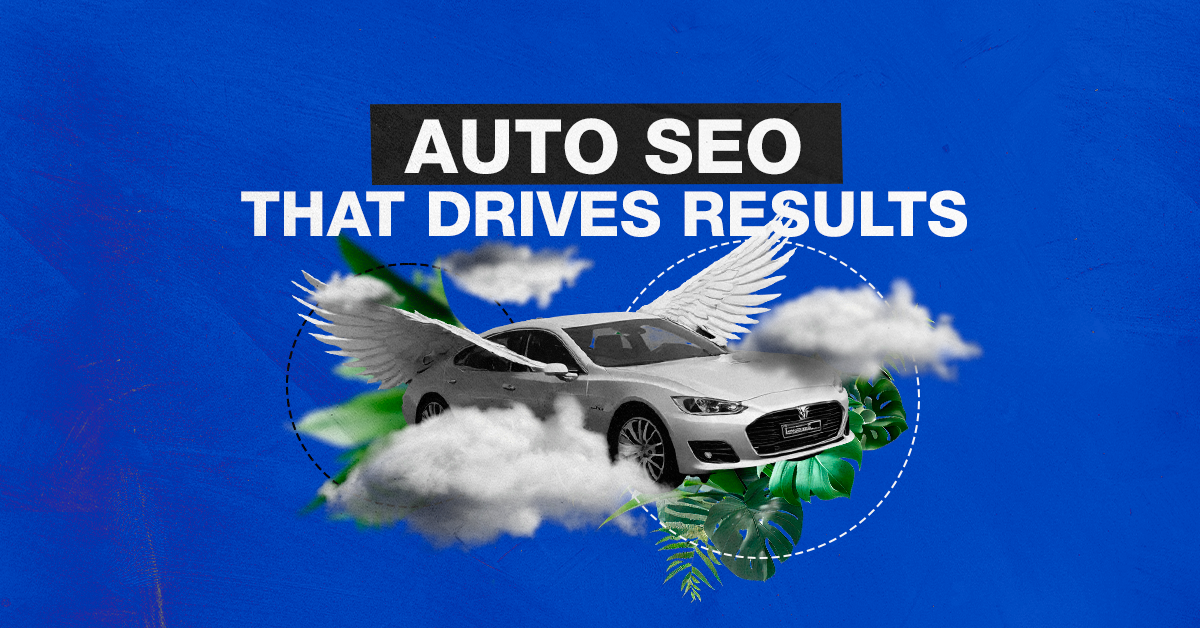
You know what's fascinating about working with automotive parts retailers over the years? I've watched countless businesses struggle with the same challenge: they've got incredible products and expertise, but their potential customers can't find them online. While I've spent most of my career helping eCommerce businesses optimize their Google Shopping campaigns, I've noticed that automotive businesses face uniquely complex SEO challenges that most general guides completely miss.
Here's the thing about automotive SEO – it's not just about ranking for "car parts" or "auto accessories." The automotive industry operates differently than traditional retail, with complex product hierarchies, technical specifications, and customer search behaviors that demand a specialized approach. Consumers overwhelmingly begin their car-buying and parts-purchasing journey online, with local intent dominating search behavior (Source: Algosaga). This means your SEO strategy needs to be as precise as a well-tuned engine.
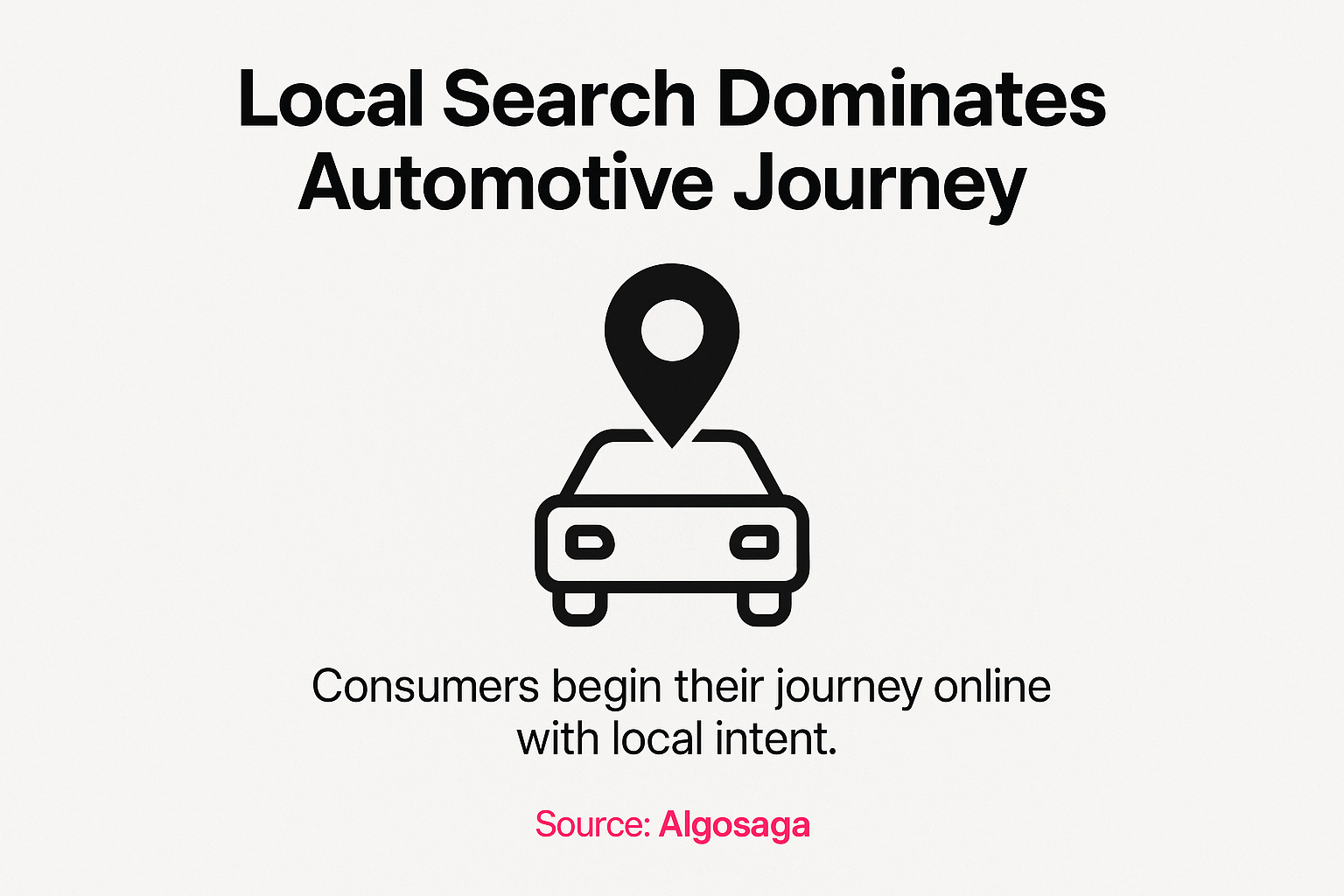
In this guide, we'll tackle the specific SEO strategies that work for automotive businesses in 2025. From local optimization tactics that put you ahead of competitors to keyword research methods that capture those valuable part-specific searches, I'll walk you through practical strategies you can implement immediately. We'll cover technical considerations, content approaches that actually convert, and current trends shaping the automotive search environment this year.
Before we get into tactics, let's talk about what makes automotive searchers different. After analyzing countless campaigns for auto parts retailers, I've discovered that automotive customers follow unique search patterns that most SEO professionals completely overlook. These aren't your typical eCommerce browsers – they're solving specific problems, often with urgent timelines and precise technical requirements.
Automotive shoppers use distinctly different search patterns compared to general retail customers. They perform part searches modified by year, make, and model combinations, conduct specific part number searches including crossover and OEM numbers, and frequently use informational queries tied directly to vehicle fitment requirements (Source: Hedges Company). What's particularly interesting is how they combine symptom-based searches like "why does my Civic make noise" with solution-focused queries for specific replacement parts.
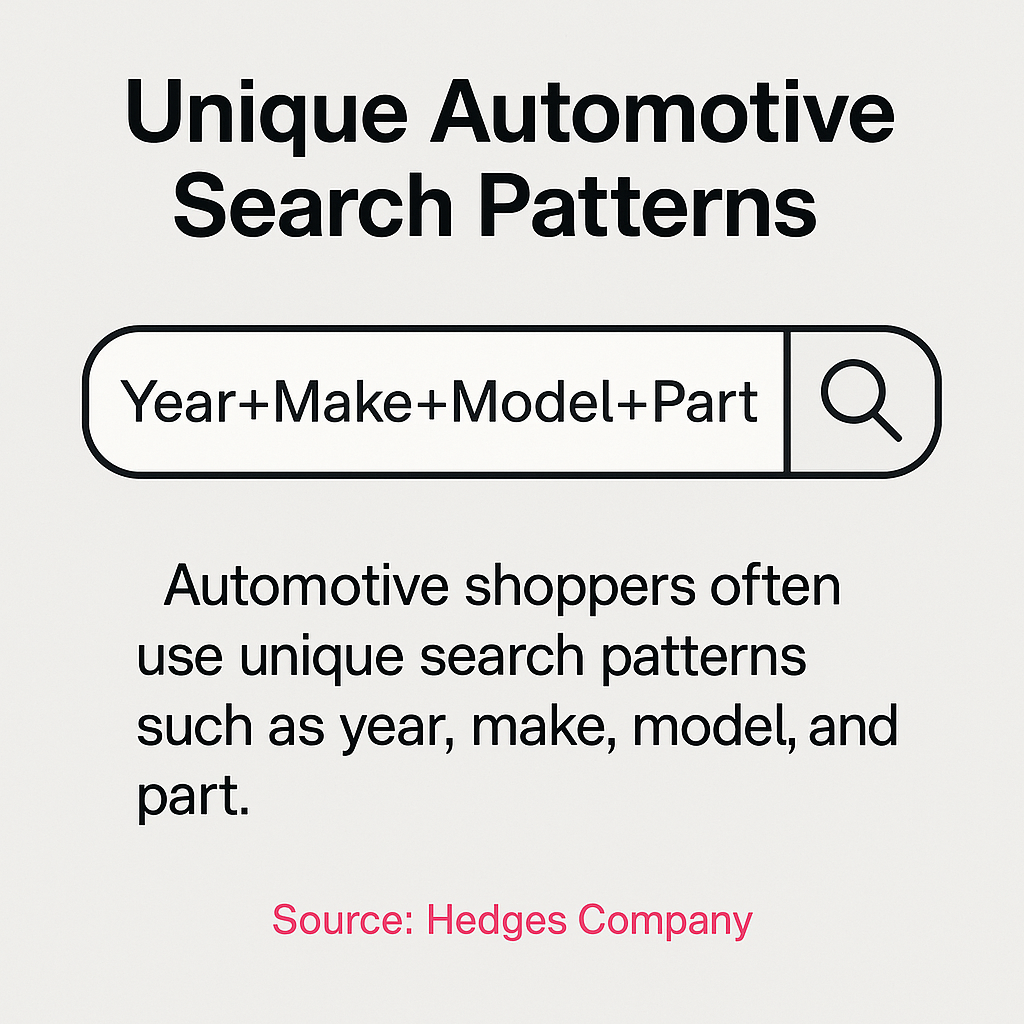
|
Search Intent Type
|
Example Queries
|
SEO Opportunity
|
|---|---|---|
|
Part-Specific
|
"2019 Honda Civic brake pads", "OEM part #04465-02370"
|
Product page optimization with detailed fitment data
|
|
Symptom-Based
|
"grinding noise when braking", "check engine light codes"
|
Educational content linking to relevant parts
|
|
Category-Level
|
"performance exhaust systems", "cold air intakes"
|
Category pages with filtering options
|
|
Comparison-Focused
|
"OEM vs aftermarket parts", "best brake pad brands"
|
Comparison guides and buying advice content
|
The key insight here is that matching these varied search intents with tailored landing pages becomes critical for success. Your customers aren't just shopping – they're problem-solving, often under time pressure. When someone searches for "alternator replacement 2015 Toyota Camry," they need immediate confirmation that you have the right part, it fits their specific vehicle, and they can get it quickly.
Local SEO represents the biggest opportunity I see automotive businesses missing. Most buyers prefer dealerships and parts suppliers in their area, yet many automotive businesses treat local optimization as an afterthought rather than the foundational strategy it should be. Let me share what actually works based on real results I've seen.
Your Google Business Profile optimization needs to go far beyond basic NAP information. Ensure your GBP includes accurate business details, relevant category tags like "auto parts store" or specific brand dealership designations, high-quality photos of your facility and inventory, and current business hours including holiday schedules (Source: Algosaga). What many businesses miss is the power of consistent NAP citations across all business directories – this identical information strengthens your local ranking signals significantly.
Location-based keyword targeting requires a more nuanced approach in automotive. You're not just competing for "auto parts near me" – you need to capture searches for specific services, brands, and even emergency situations in your area. Consider our detailed automotive digital marketing approach that integrates local SEO with broader marketing strategies.
|
Local SEO Element
|
Automotive-Specific Implementation
|
Expected Impact
|
|---|---|---|
|
Google Business Profile
|
Complete with inventory photos, service capabilities, brand specializations
|
Higher local pack visibility, increased click-through rates
|
|
Location Keywords
|
"Honda service [city]", "brake repair near [landmark]", "24-hour auto parts [area]"
|
Capture geo-intent searches with commercial value
|
|
Local Citations
|
Automotive directories, service databases, manufacturer locators
|
Improved domain authority and local relevance signals
|
|
Review Management
|
Encourage service-specific reviews, respond to technical questions
|
Enhanced trust signals and long-tail keyword coverage
|
Here's something that might surprise you: Google Maps integration on your contact page isn't just about user experience – it actually improves your local relevance signals (Source: Algosaga). I've seen this simple addition contribute to noticeable improvements in local search visibility for automotive businesses.
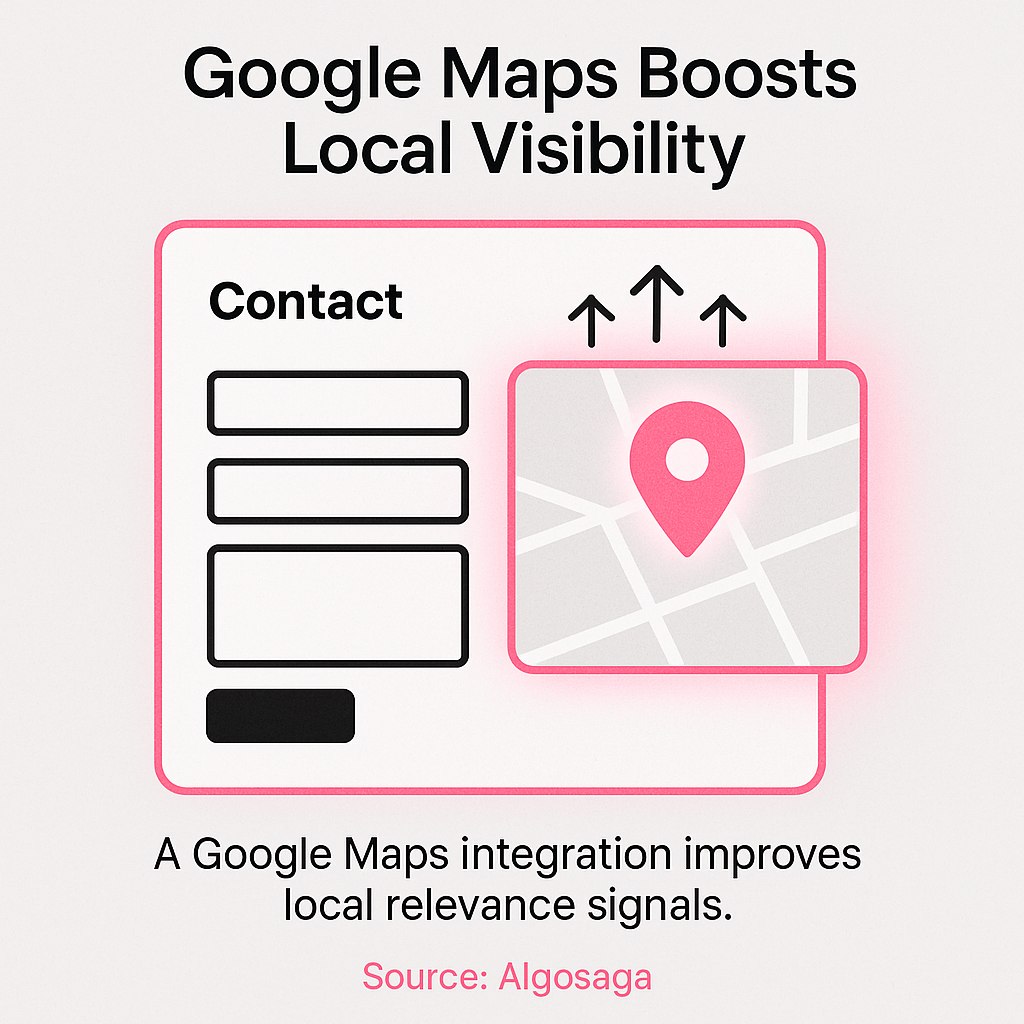
Traditional keyword research tools often fall short in automotive markets. The complexity of vehicle applications, part cross-references, and technical specifications creates keyword opportunities that standard approaches miss entirely. I've developed a more targeted methodology that captures the full spectrum of automotive search behavior.
Start by understanding that automotive customers search across multiple knowledge levels simultaneously. A single visitor might search for both "transmission fluid change" and "Dexron VI ATF specification" within the same shopping session. This means your keyword strategy needs to address both educational and transactional intent for the same core topics.
The real opportunity lies in part number and specification-based keywords that most competitors ignore. These searches often have lower competition but higher commercial intent – someone searching for a specific OEM part number is much closer to purchase than someone browsing general categories. For detailed optimization techniques, check out our guide on optimizing automotive product listings for maximum search visibility.
Automotive websites face unique technical challenges that can make or break your SEO performance. Large inventory databases, complex filtering systems, and frequently changing stock levels create problems that require specialized solutions. Let me walk you through the technical foundations that actually matter for automotive SEO success.
Your inventory pages function as product pages, which means they need to be optimized accordingly. Use clear URL structures that reflect your inventory hierarchy, such as /inventory/performance-parts/cold-air-intakes/honda/, rather than generic database-generated URLs. Include comprehensive product information including detailed specifications, multiple high-resolution images, clear pricing, availability status, and prominent calls-to-action (Source: Ahrefs).
The filtering challenge deserves special attention. While product filters improve user experience, they can create massive indexation issues if not handled properly. Test new filtering features with high-volume product categories before scaling across your entire site, and use canonical tags strategically to prevent diluting your search authority across similar pages.
|
Technical Element
|
Automotive Challenge
|
SEO Solution
|
|---|---|---|
|
URL Structure
|
Complex product hierarchies and applications
|
Logical hierarchy: /category/subcategory/brand/product-name
|
|
Product Filtering
|
Multiple fitment and specification filters
|
Strategic canonicalization and parameter handling
|
|
Image Optimization
|
Detailed product photos and diagrams
|
Descriptive filenames, alt text with part numbers and applications
|
|
Schema Markup
|
Complex product specifications and compatibility
|
Product schema with detailed automotive attributes
|
Schema markup implementation offers tremendous opportunities in automotive SEO that most businesses completely miss. FAQPage schema for sections like recall check tools or service FAQs can significantly boost your click-through rates through enhanced search result listings (Source: Sterling Sky). I've seen automotive businesses achieve notable performance improvements simply by implementing structured data for their most valuable content sections.
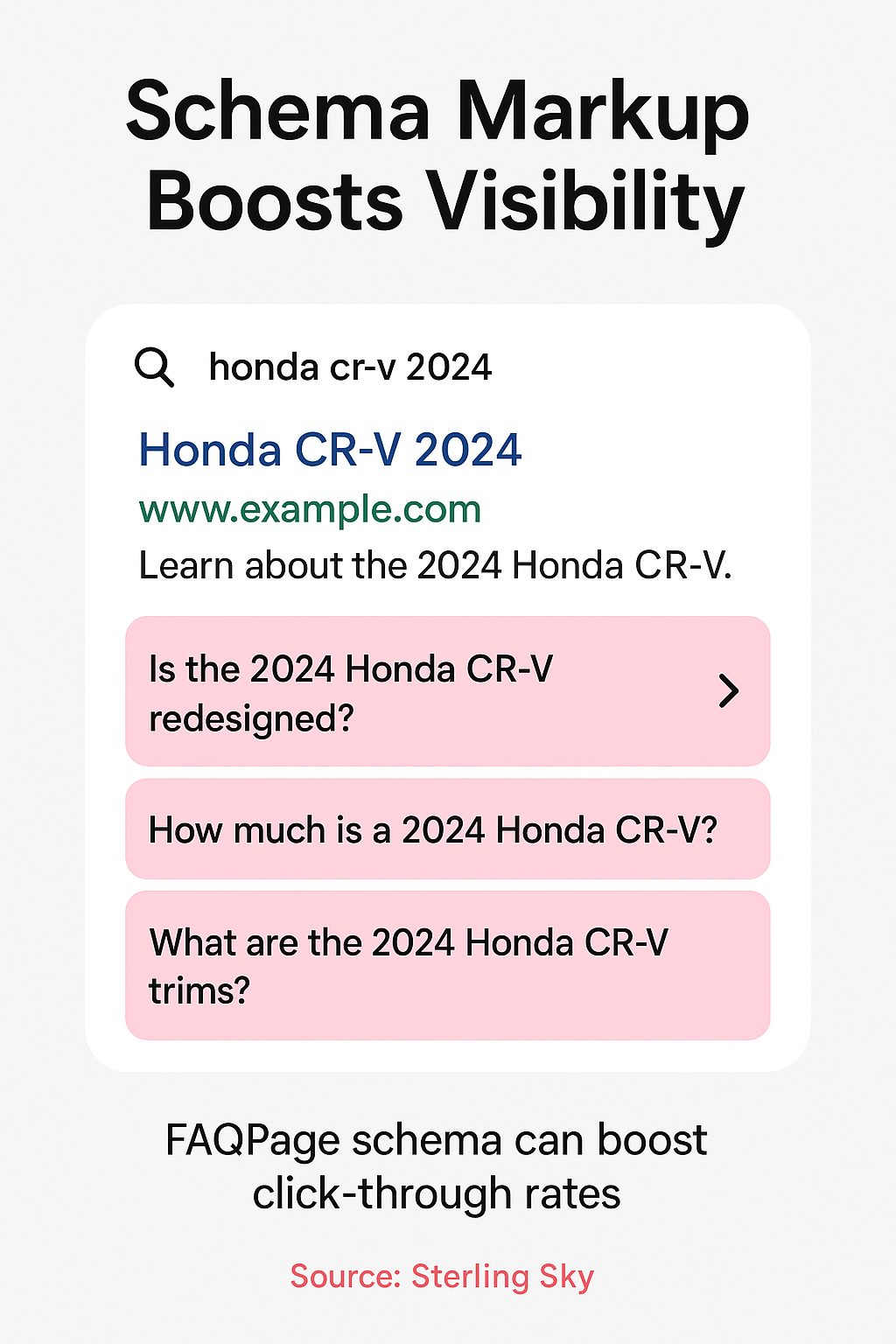
Content marketing in automotive requires a different approach than most industries. Your customers aren't browsing for inspiration – they're solving specific problems, often with vehicles they rely on daily. This creates unique opportunities to provide value while naturally leading visitors toward your products and services.
The most effective automotive content addresses the complete customer journey from problem identification through solution implementation. Create fresh content optimized around specific makes and models, develop detailed installation guides that showcase your expertise, and build comparison resources that help customers choose between different options. For broader context on automotive content strategies, our automotive content marketing metrics guide shows how to measure success effectively.
Here's what I've learned works exceptionally well: curated landing pages that target specific customer situations. Pages focused on "family-friendly modifications," "first car essentials," or "off-road upgrade packages" create strong user experiences that match search intent while naturally showcasing relevant products (Source: Ahrefs). These pages often outperform generic category pages because they speak directly to customer needs.
|
Content Type
|
Automotive Application
|
SEO Benefit
|
|---|---|---|
|
Installation Guides
|
Step-by-step tutorials for popular modifications
|
Captures "how to" searches and builds authority
|
|
Troubleshooting Articles
|
Common problems and diagnostic procedures
|
Targets symptom-based searches with high intent
|
|
Product Comparisons
|
OEM vs aftermarket, brand comparisons, performance testing
|
Captures commercial investigation queries
|
|
Vehicle-Specific Guides
|
Popular modifications for specific makes/models
|
Targets enthusiast communities with buying power
|
Mobile optimization takes on special importance in automotive markets because customers often search on mobile while actually working on their vehicles or visiting physical locations. They need information quickly, often in less-than-ideal conditions, which means your mobile experience needs to be exceptionally clear and fast.
Your mobile site needs to prioritize essential information: part availability, fitment confirmation, pricing, and contact options. Clickable phone numbers become especially important for mobile conversions in automotive, as customers frequently need immediate assistance with technical questions or urgent orders (Source: Sterling Sky). Consider our mobile optimization strategies that focus specifically on automotive user needs.
Page speed becomes critical when customers are searching for parts they need immediately. A slow-loading product page can literally cost you sales to competitors who provide faster access to the same information. Focus on optimizing your core conversion paths: homepage to category to product to checkout.
In automotive markets, reputation management directly impacts your SEO performance in ways that many other industries don't experience. Customers researching automotive purchases place enormous weight on peer experiences, especially for technical products where mistakes can be expensive.
Here's a crucial statistic: 84% of consumers trust online reviews as much as personal recommendations, and positive reviews on platforms like Google, Yelp, and automotive-specific sites directly influence both search rankings and conversion rates (Source: Algosaga). This makes review management both a customer service priority and an SEO strategy.
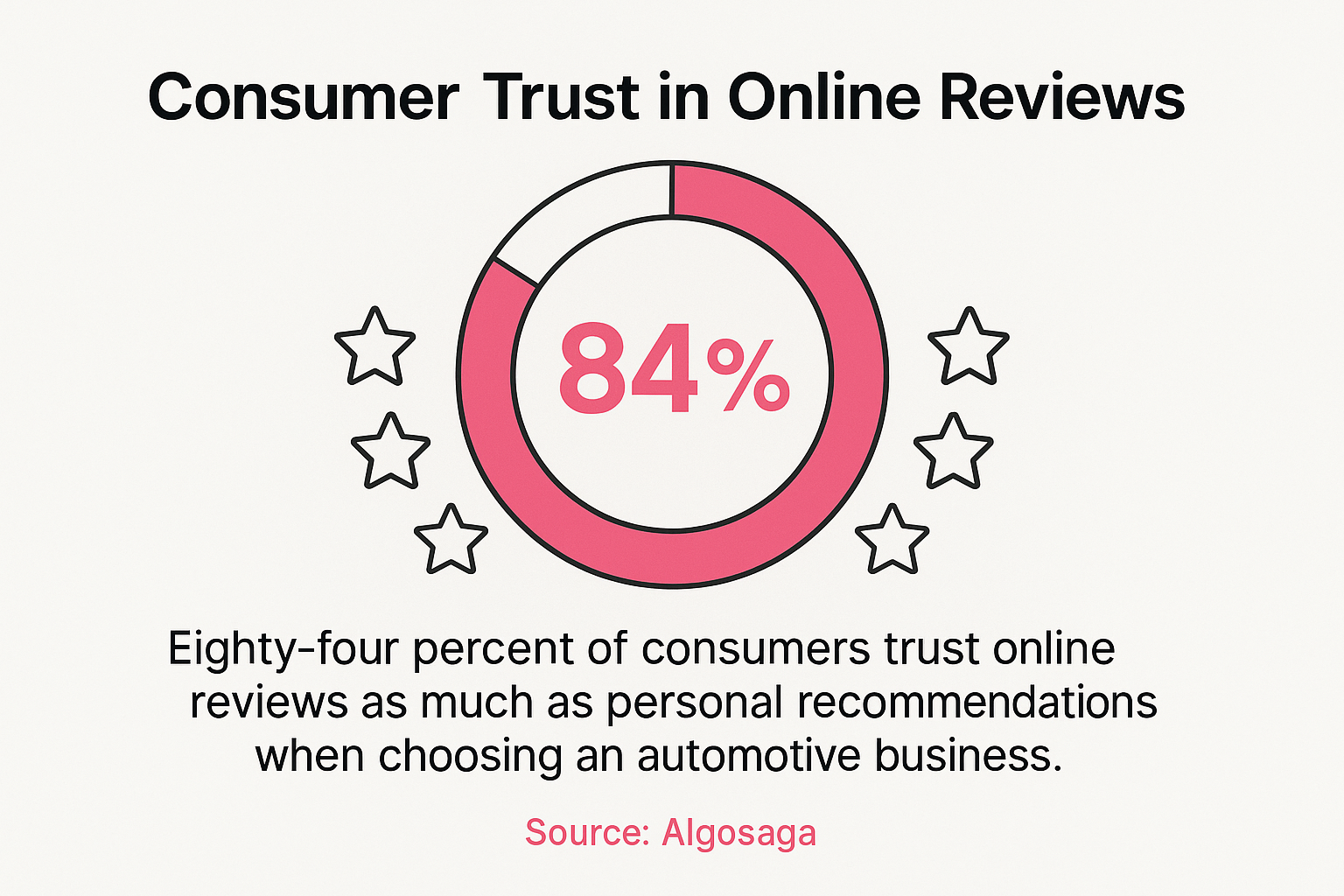
Review schema markup implementation can make your business stand out in search results through rich snippets that display star ratings and review counts directly in search listings. This enhanced visibility often leads to higher click-through rates even when you're not ranking in the top position.
Converting automotive traffic requires understanding the unique decision-making process your customers follow. Unlike impulse purchases, automotive buying often involves research, comparison, and technical verification before purchase. Your conversion optimization needs to support this more complex journey.
Prominent calls-to-action on your product and landing pages should address the specific concerns automotive customers have: "Check Compatibility," "Verify Fitment," "Get Installation Support," and "Call for Technical Questions." Even when real-time inventory fluctuates, maintaining clear conversion paths keeps potential customers engaged rather than leaving for competitors.
Trust signals become especially important in automotive eCommerce. Display certifications, warranty information, return policies, and technical support options prominently. Customers making significant automotive purchases need confidence that you'll support them through installation and beyond. Our broader eCommerce implementation strategies provide additional context for building trust throughout the customer journey.
|
Conversion Element
|
Automotive-Specific Implementation
|
Impact on Sales
|
|---|---|---|
|
Product Information
|
Detailed fitment charts, installation complexity ratings, warranty terms
|
Reduces uncertainty and cart abandonment
|
|
Trust Signals
|
Technical certifications, customer photos, installation support
|
Increases confidence for high-value purchases
|
|
Call-to-Action
|
"Check Fitment," "Get Tech Support," mobile-optimized phone numbers
|
Improves conversion rate and customer satisfaction
|
|
Support Options
|
Live chat for technical questions, installation guides, video tutorials
|
Reduces pre-purchase anxiety and support costs
|
The automotive SEO environment continues to shift rapidly in 2025, with AI-driven changes reshaping how customers interact with search results and automotive websites. Understanding these trends helps you adapt your strategy proactively rather than scrambling to catch up after algorithm updates impact your rankings.
AI search is changing everything in automotive SEO, requiring continuous adaptation based on customer research and data analysis (Source: Hedges Company). What's particularly interesting is how AI affects automotive searches differently than general retail – the technical specificity and safety implications of automotive purchases mean that searchers still value detailed, expert content over generic AI-generated responses.
Voice search adoption impacts automotive queries significantly, especially for mobile users who might ask their devices for "nearest Toyota parts dealer" or "how to change brake pads on 2020 Honda Civic" while working in their garage. Optimizing for conversational queries becomes increasingly important for capturing this growing search behavior.
Stay current with automotive SEO by monitoring your specific market segments rather than general SEO news. The automotive industry often experiences different impacts from algorithm updates compared to other sectors. For insights into broader automotive digital trends, our analysis of eCommerce transformation in automotive provides valuable context for long-term strategy planning.
Measuring automotive SEO success requires tracking metrics that actually correlate with business growth rather than vanity metrics that look impressive but don't drive revenue. Focus on qualified traffic that leads to sales rather than just increasing overall visitor counts.
Track search visibility for your most valuable keywords – those part numbers, applications, and service terms that drive actual purchases. Monitor local search performance separately from general organic results, since local visibility often matters more for automotive businesses than broader rankings.
Conversion tracking becomes complex in automotive because customers often research extensively before purchasing, sometimes over weeks or months. Set up proper attribution models that account for multiple touchpoints and longer sales cycles. For additional guidance on automotive SEO growth, our aftermarket parts SEO strategies provide specific tactics for improving sales performance through search optimization.
|
Metric Category
|
Key Performance Indicators
|
Success Indicators
|
|---|---|---|
|
Search Visibility
|
Rankings for branded terms, part categories, local searches
|
Consistent improvement in target keyword positions
|
|
Traffic Quality
|
Pages per session, time on product pages, qualified lead generation
|
Higher engagement from automotive-intent visitors
|
|
Conversion Performance
|
Product page conversion rates, average order value, repeat purchases |
Improved sales from organic search traffic
|
|
Local Performance
|
Google Business Profile views, direction requests, local pack visibility
|
Increased local market share and foot traffic
|

Now that we've covered the strategies, let's talk about practical implementation. The biggest mistake I see automotive businesses make is trying to tackle everything simultaneously rather than focusing on the tactics that will deliver the fastest results for their specific situation.
Start with your Google Business Profile optimization and local citations if you serve local customers. These improvements often show results within a few weeks and provide immediate visibility benefits. Next, focus on your highest-traffic product pages – optimize these for both search engines and conversion before expanding to your entire catalog.
Content creation should follow a strategic priority: address your most common customer questions first, optimize for your highest-value keywords, and create resources that showcase your expertise while supporting sales. For businesses ready to implement these strategies systematically, our automotive marketing services provide the expertise and support to accelerate results.
Here's what I want you to take away from this guide: automotive SEO isn't just about technical optimization – it's about understanding your customers' unique needs and building digital experiences that serve them effectively. Whether you're selling parts, providing services, or supporting automotive enthusiasts, your SEO strategy needs to reflect the specific way your customers search, evaluate, and purchase in your market.
The automotive industry continues to shift toward digital-first customer experiences, making SEO more critical than ever for long-term success. The businesses that thrive will be those that combine technical SEO excellence with deep understanding of automotive customer behavior – exactly the approach we've outlined in this guide.
Our customers value boutique agency approach with access to a seasoned team, profit-based goals, and clear communication.



